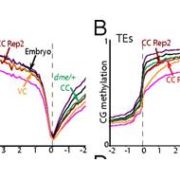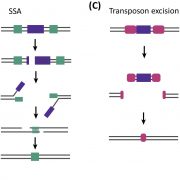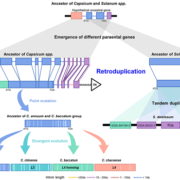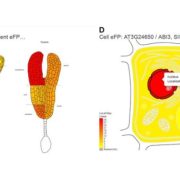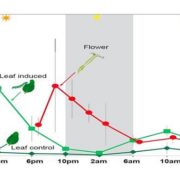EIN2 mediates direct regulation of histone acetylation in the ethylene response
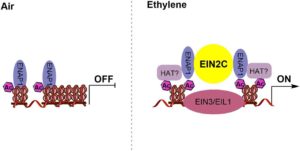 Perception of the phytohormone ethylene results in the cleavage of EIN2 and translocation to the nucleus of its C-terminal end, EIN2-C. Zhang et al. showed that EIN2-C is essential for chromatin modification that allows EIN3, the main ethylene signaling transcription factor, to transcriptionally regulate its target genes. The authors demonstrated that EIN2-C is a key factor in the histone acetylation of H2K14 and H3K23, although they were unable to locate a histone acetyltransferase (HAT) motif within EIN2-C. However, EIN2-C is known to bind to the EIN2 nuclear associated protein1 (ENAP1) which is capable of binding to chromatin. The authors went on to show that ENAP1 is enriched in areas of the chromatin containing ethylene responsive promoters and that it remains bound to these areas in both the presence and absence of ethylene. However, only when ENAP1 is associated with EIN2-C are H2K14Ac and H3K23Ac levels elevated, promoting the binding of EIN3 and the rapid transcriptional regulation of ethylene responsive genes. The authors suggest that ENAP1 is serving as a placeholder to keep chromatin open and available for rapid transcription and that EIN2-C is actually driving histone acetylation. Further research is needed to identify if EIN2-C is a novel HAT or if another HAT protein is involved in this process. Regardless, this study clearly demonstrates a mechanism for the integration of hormone signaling, chromatin remodeling, and gene regulation. (Summary by Jennifer Robison) Proc. Natl. Acad. Sci. USA 10.1073/pnas.1707937114
Perception of the phytohormone ethylene results in the cleavage of EIN2 and translocation to the nucleus of its C-terminal end, EIN2-C. Zhang et al. showed that EIN2-C is essential for chromatin modification that allows EIN3, the main ethylene signaling transcription factor, to transcriptionally regulate its target genes. The authors demonstrated that EIN2-C is a key factor in the histone acetylation of H2K14 and H3K23, although they were unable to locate a histone acetyltransferase (HAT) motif within EIN2-C. However, EIN2-C is known to bind to the EIN2 nuclear associated protein1 (ENAP1) which is capable of binding to chromatin. The authors went on to show that ENAP1 is enriched in areas of the chromatin containing ethylene responsive promoters and that it remains bound to these areas in both the presence and absence of ethylene. However, only when ENAP1 is associated with EIN2-C are H2K14Ac and H3K23Ac levels elevated, promoting the binding of EIN3 and the rapid transcriptional regulation of ethylene responsive genes. The authors suggest that ENAP1 is serving as a placeholder to keep chromatin open and available for rapid transcription and that EIN2-C is actually driving histone acetylation. Further research is needed to identify if EIN2-C is a novel HAT or if another HAT protein is involved in this process. Regardless, this study clearly demonstrates a mechanism for the integration of hormone signaling, chromatin remodeling, and gene regulation. (Summary by Jennifer Robison) Proc. Natl. Acad. Sci. USA 10.1073/pnas.1707937114



